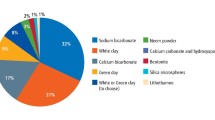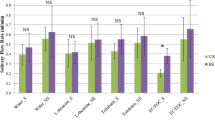Abstract
Tea is the second most commonly consumed drink in the world. Excess fluoride intakes from tea drinks may cause health effects. This work assesses infusible fluoride levels in popular tea sold in Taiwan and evaluates potential exposure factors. Lungjing, pouchong, tienguanyin, oolong, pureh, and black tea specimens were purchased from different counties in Taiwan. Fluoride levels were evaluated in one complete cycle of tea making as well as at different calcium carbonate contents in water, with glass or porcelain teapots, and with/without adding sugar. Oolong tea leaves in each manufacturing step were also analyzed for infusible fluoride. Potential fluoride intakes and risks are estimated based on a national survey. Among six kinds of tea, black tea had the highest fluoride concentrations (8.64±2.96 mg/l), whereas pureh (1.97±2.70 mg/l) had the lowest levels. Higher percentages of infusible fluoride can be rinsed away from tea leaves curved lengthways compared to those curved end-to-end in the first 2.5 min. The use of glass or porcelain teapots and calcium carbonate content (up to 400 mg/l) in water would not affect infusible fluoride levels, whereas adding sugar increased the infusible fluoride in the first few minutes. In addition, it was found that the critical step during the manufacturing process affecting the percentage of infusible fluoride was ball rolling rather than fermentation. Furthermore, intakes of high amounts (≥5 l/week) of certain tea may result in excess risks of dental or skeletal fluorosis. Tea lovers could be exposed to excess fluoride and may be at risk of fluorosis.
This is a preview of subscription content, access via your institution
Access options
Subscribe to this journal
Receive 6 print issues and online access
$259.00 per year
only $43.17 per issue
Buy this article
- Purchase on Springer Link
- Instant access to full article PDF
Prices may be subject to local taxes which are calculated during checkout





Similar content being viewed by others
References
Bardsen A., Klock K.S., and Bjorvatn K. Dental fluorosis among persons exposed to high- and low-fluoride drinking water in western Norway. Commun Dent Oral Epidemiol 1999: 27: 259–267.
Cao J., Bai X., Zhao Y., Liu J., Zhou D., Fang S., Jia M., and Wu J. The relationship of fluorosis and brick tea drinking in Chinese Tibetans. Environ Health Perspect 1996: 104: 1340–1343.
Chie W.C., Yang R.S., Liu J.P., and Tsai K.S. High incidence rate of hip fracture in Taiwan: estimated from a nationwide health insurance database. Osteoporosis Int 2004: 15: 998–1002.
Cittanova M.L., Lelongt B., Verpont M.C., Geniteau L., Legendre M., Wahbe F., Prie D., Coriat P., and Ronco P.M. Fluoride ion toxicity in human kidney collecting duct cells. Anesthesiology 1996: 84: 428–435.
CMNHW. Tapwater Consumption in Canada, Document number 82-EHD-80 Public Affairs Directorate, Department of National Health and Welfare, Canadian Ministry of National Health and Welfare, Ottawa, Canada, 1981.
CWB. Climatological Data Annual Report Part I, surface data (Taiwan area). Central Weather Bureau, Ministry of Transportation and Communications, Executive Yuan, Republic of China, Taipei, 1999.
DGBAS. Statistical Yearbook of the Republic of China. Directorate-General of Budget, Accounting and Statistics. Executive Yuan, Taipei, Taiwan, ROC, 2005 (in Chinese).
Erdal S., and Buchanan S.N. A quantitative look at Fluorosis, fluoride exposure, and intake in children using a health risk assessment approach. Environ Health Perspect 2005: 113: 111–117.
Fung K.F., Zhang Z.Q., Wong J.W.C., and Wong M.H. Fluoride contents in tea and soil from tea plantations and the release of fluoride into tea liquor during infusion. Environ Pollut 1999: 104: 197–205.
Galagan D.J., and Vermillio J.R. Determining optimum fluoride concentrations. Public Health Rep 1957b: 72: 491–493.
Galagan D.J., Vermillion J.R., Nevitt G.A., Stadt A.M., and Dart R.E. Climate and fluid intake. Public Health Rep 1957: 72: 485–490.
Gulati P., Singh V., Gupta M.K., Vaidya V., Dass S., and Prakash S. Studies on the leaching of fluoride in tea infusions. Sci Total Environ 1993: 138: 213–222.
Hopkins S.M, and Ellis J.C Drinking water consumption in Great Britain: a survey of drinking habits with special reference to tap-water-based beverages. Technical Report 137 Water Research Centre, Wiltshire, Great Britain, 1980.
Huang T.Y, (Ed.). Chinese Tea-making. Chang Wen Publishers, Taipei, Taiwan, 1991 pp. 81–145 (in Chinese).
Ismail A.I., and Messer J.G. The risk of fluorosis in students exposed to a higher than optimal concentration of fluoride in well water. J Public Health Dent 1996: 56: 22–27.
Kanis J.A., Johnell O., De Laet C., Jonsson B., Oden A., and Ogelsby A.K. International variations in hip fracture probabilities: implications for risk assessment. J Bone Miner Res 2002: 17: 1237–1244.
Karthikeyan G., Pius A., and Apparao B.V. Contribution of fluoride in water and food to the prevalence of fluorosis in areas of Tamil Nadu in South India. Fluoride-Quarterly Rep 1996: 29: 151–155.
Klaassen C.D. Toxic reponses of the kidney. In: Casarett and Doull's Toxicology: The Basic Science of Poisons, 6th edn. McGraw-Hill Companies Inc., New York, 2001, 499.
Kumar J.V., and Swango P.A. Fluoride exposure and dental fluorosis in Newburgh and Kingston, New York: policy implications. Commun Dent Oral Epidemiol 1999: 27: 171–180.
Lai P.Y. Pureh Tea, 1st edn. Ying-Ji Tang-Zen Craft Publisher, Taipei, 2003 (In Chinese).
Li Y.M., Liang C.K., Shemenda C.W., Ji R.D., Sun S.Z., Cao J.X., Emsley C.L., Ma F., Wu Y.P., Ying P., Zhang Y., Gao S.J., Zhang W., Katz B.P., Niu S.R., Cao S.R., and Johnston C.C. Effect of long-term exposure to fluoride in drinking water on risks of bone fractures. J Bone Miner Res 2001: 16: 932–939.
Lin P.C., and Lu C.M. Hip fracture: family caregivers’ burden and related factors for older people in Taiwan. J Clin Nurs 2005: 14: 719–726.
Lung S.C., Shiau B.G., and Chiang K.M. Fluoride concentrations in three types of commercially packed tea drinks in Taiwan. J Expo Anal Env Epid 2003: 13: 66–73.
Manil C., and Zbinden M. Tea Time. Cassell & Co., London, UK, 2001 pp. 32–65.
Morgen L., Allres D., Tavares M., Bellinger D., and Needleman H. Investigation of the possible associations between fluorosis, fluoride exposure, and childhood behavior problems. Pediatr Dent 1998: 20: 244–252.
Pan W.-H., Kao M.-D., Tzeng M.-S., Yen L.-L., Hung Y.-T., Li L.-A., Hsiao S.-Y., Yeh W.-T., and Huang P.-C. Nutrition and Health Survey in Taiwan (NAHSIT) 1993–1996: design, contents, and operations. Nutr Sci J 1999: 24: 1–10.
Shyu Y.I.L., Chen M.C., Liang J., Lu J.F.R., Wu C.C., and Su J.Y. Changes in quality of life among elderly patients with hip fracture in Taiwan. Osteoporosis Int 2004: 15: 95–102.
TEPA. Drinking Water Standard. Taiwan Environmental Protection Administration, Executive Yuan, Taipei, Taiwan, 2005 (in Chinese).
TRES. Manufacturing Processes of Tea. The Research and Extension Station, Council of Agriculture, Executive Yuan, Taipei, Taiwan, 2002.
TTPIA. Introduction to Taiwanese Tea Production. Taiwan Tea-Production Industry Association, Taipei, Taiwan, Available at http://www.taiwantea.org.tw, 2006a (accessed 1 February 2006, in Chinese).
TTPIA. Statistical Table for Tea Export. Taiwan Tea-Production Industry Association, Taipei, Taiwan, Available at http://www.taiwantea.org.tw, 2006b (accessed 1 February 2006, in Chinese).
Tzeng M.-S., Kao M.-D., Yeh W.-T., and Pan W.-H. Food consumption frequency and eating habit among Taiwanese — NAHSIT 1993–1996. Nutr Sci J 1999: 24: 59–80.
US DA. Food and Nutrient Intakes by Individuals in the United States, 1 day, 1989–91, NFS Report No. 91-2. United States Department of Agriculture, Agricultural Research Service, 1995.
US EPA. Integrated Risk Information System. United States Environmental Protection Agency, Washington, DC, 1989a last revised June 1, 1989.
US EPA. Risk Assessment Guidance for Superfund, Vol. 1: Human Health Evaluation Manual (Part A). EPA/540/1-890002. US Environmental Protection Agency, Office of Emergency Response,Washington, DC, 1989b.
Villa A.E., Guerrero S., and Villalobos J. Estimation of optimal Concentration of fluoride in drinking water under conditions prevailing in Chile. Commun Dent Oral Epidemiol 1998: 26: 249–255.
WHO. Water, Sanitation and Health: Guidelines for Drinking Water Quality, Health Criteria and Other Supporting Information, 2nd edn., Vol. 2, World Health Organization, Geneva, Switzerland, 1996 pp. 231–237.
WHO. Water-related Diseases. Fluorosis: The Disease and How It Affects People.. World Health Organization, Geneva, Available at: http://www.who.int/water_sanitation_health/diseases/fluorosis/en/, 2001 (accessed 12 January 2004).
WHO. World Water Day 2001: Oral Health. World Health Organization, Geneva, Available at http://www.who.int/entity/water_sanitation_health/en/oralhealth.htm, 2002 (accessed 12 January 2004).
Yang C.Y., Cheng M.F., Tsai S.S., and Hung C.F. Fluoride in drinking water and cancer mortality in Taiwan. Environ Res Section A 2000: 82: 189–193.
Zhao L.B., Liang G.H., Zhang D.N., and Wu X.R. Effect of a high fluoride water supply on children's intelligence. Fluoride 1996: 29: 190–192.
Acknowledgements
This publication was made possible by grant number NSC90–2815-C-040–009-B from National Science Council (NSC), Republic of China. Its contents are solely the responsibility of the authors and do not necessarily represent the official view of the NSC.
Author information
Authors and Affiliations
Corresponding author
Rights and permissions
About this article
Cite this article
Lung, SC., Cheng, HW. & Fu, C. Potential exposure and risk of fluoride intakes from tea drinks produced in Taiwan. J Expo Sci Environ Epidemiol 18, 158–166 (2008). https://doi.org/10.1038/sj.jes.7500574
Received:
Accepted:
Published:
Issue Date:
DOI: https://doi.org/10.1038/sj.jes.7500574
Keywords
This article is cited by
-
Intake of fluoride and other Hofmeister ions from black tea consumption in CKDu prevalent areas, Sri Lanka
Environmental Science and Pollution Research (2023)
-
Fluoride concentration in teas derived from Camellia Sinensis produced in Argentina
Environmental Monitoring and Assessment (2022)
-
A combined analytical-chemometric approach for the in vitro determination of polyphenol bioaccessibility by simulated gastrointestinal digestion
Analytical and Bioanalytical Chemistry (2022)
-
Effects of brewing conditions on infusible fluoride levels in tea and herbal products and probabilistic health risk assessment
Scientific Reports (2021)
-
Does fluoride cause the mysterious chronic kidney disease of multifactorial origin?
Environmental Geochemistry and Health (2020)



